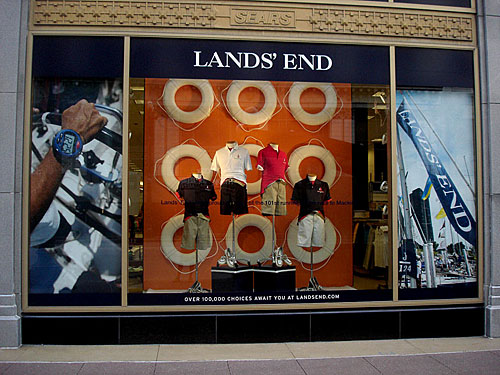
When Jerome Griffith took over the helm at Lands’ End as CEO two years ago, he had been on the verge of actual retirement. But when the opportunity to take over at Lands’ End came up, he decided to extend his tour of duty in the working world for two reasons.
“I didn’t really feel like sitting around the house being retired,” Griffith jokingly noted in an interview with Marketplace.
The more serious issue that drew him to the job, however, was the peculiar way in which Lands’ End was running. The company was best known to the public as a nice, safe, legacy brand most famous for its catalog business from the ’80s and ’90s. By 2017, of course, Lands’ End was well down the road from its catalog-dependent early days — but the company wasn’t being run that way. Despite that fact that 87 percent of their goods were being sold online in some capacity, the company was still beholden to some very old ways.
“It was being run like a catalog company from the ’80s with systems from the ’80s,” he noted, which was a problem, because even though Lands’ End customers do tend to skew a bit older — and remember shopping during the 1980’s — they aren’t exactly ecstatic to be returning to that set of glory days. The challenge for the company, and the place where its investments and hiring priorities have gone, according to its CEO, is into building out an online experience comparable to that of any other digital innovator out there.
“Our average consumer is in their early 50s. They’re relatively affluent. They live in the suburbs. They use their smartphone. They value comfort. They are more digitally savvy than what you would actually expect,” Griffith said, noting that over the last 18 to 24 months, that average age has been creeping down some.
Not a lot — he was careful to note that it was not a “radical shift,” and that in general, that is a good thing Firms pushing radical shifts in business are taking a big risk in alienating their current customers, he said — and customer retention is critical to Lands’ End’s long-term strategy in the retail market. But the drift is there, he notes, and due at least in part to Lands’ End’s decision to set up a digital storefront on Amazon.
That move has been somewhat controversial, especially among larger brands who see Amazon’s continual creep into the apparel market as a threat to their business, and are thus less than interested in tying their customers’ shopping data into Amazon’s stream. But for Griffith, that debate fundamentally misses the point.
“More than 50 percent of all searches on clothing are on Amazon. So if you’re not on Amazon, you’re not relevant. Full stop.”
The reality, he noted, is often a lot more complex that the narratives about whether Amazon is more a help or hindrance to its branded partners. The reality in Lands’ End’s case, according to their CEO, is that the partnership has been good for Lands’ End because of all the new customers it has brought it.
Moreover, he noted, the Amazon Lands’ End shop isn’t competing with its core, proprietary eCommerce business. The Amazon customers skew both a bit younger and more male than Lands’ End’s average customer base. And they aren’t already regular customers.
“And what we also find is that over half of our sales on Amazon are through customers that have never dealt with the brand Lands’ End before — and another 27 percent of our customers that did shop at Lands’ End once but haven’t shopped there in over a year, up to five years. So there’s very little existing customer crossover. And as long as that stays true and as long as we’re still selling our bestsellers on Amazon, same as we do on our own website, we’ll stick with them. They’ve been a good partner so far.”
And, he noted, it is also about building out the Lands’ End brand across channels. It is why the chain is expanding its number of physical stores — alongside its efforts to beef up its digital offerings. Because ultimately, the heart of Lands’ End’s transformation over the last two years has been about customer experience — and realizing it’s about meeting customers where they are. Wherever they are.